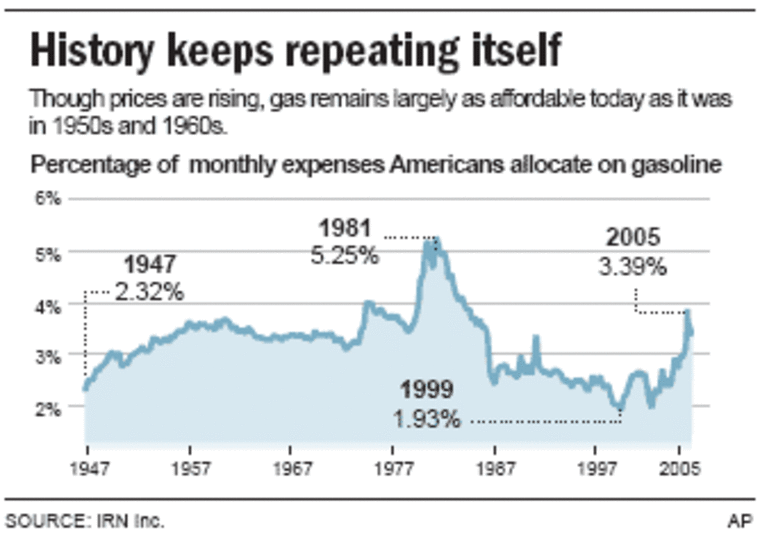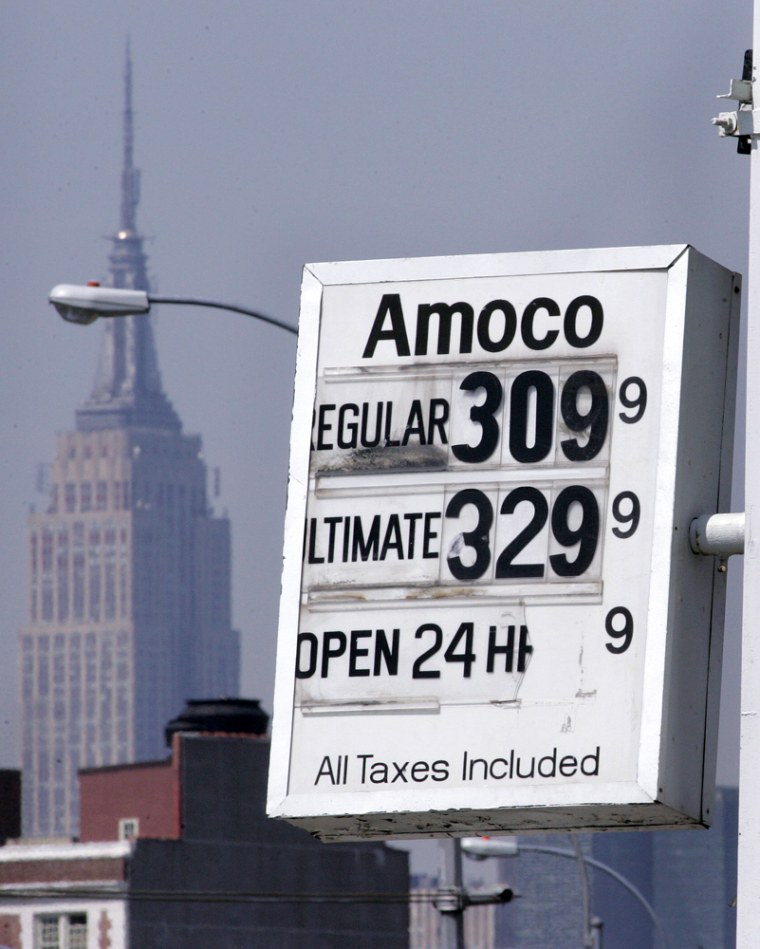With pump prices still rising, spot outages of gasoline cropping up in some East Coast markets, and proposed solutions gaining momentum in Congress, President Bush’s plan to ease gasoline prices is aimed at calming growing consumer anger at the rising cost of filling up.
But the measures announced Tuesday aren’t likely to alter the forces that are pushing up the cost of crude oil, straining the supplies of gasoline to U.S. motorists and sending pump prices higher each week.
For starters, there is little the White House or Congress can do to control the price of crude. At recent highs of $75 a barrel, the cost of crude oil has jumped by a third since November as demand for oil continues to grow faster than global production capacity. Nervous oil buyers are paying these high prices because they're worried about possible supply bottlenecks from multiple hot spots like Iraq, Nigeria and Iran.
And the biggest single factor driving up the price of a gallon of gas is the sharp increase in oil prices.
"The reasons for high gasoline prices are very clear: the high cost of crude and the high cost of manufacturing gasoline," said John Felmy, chief economist for the American Petroleum Institute. "The idea that this is some sort of conspiracy is very unfortunate."
Bush's call to halt shipments of oil into the U.S. Strategic Petroleum Reserve will have little impact on global prices. With U.S. demand for oil running about 450 million barrels a month, less than half of one percent is diverted to the SPR.
On top of higher crude prices, the current rise in pump price is also seasonal: as the weather warms up and the summer driving season approaches, demand picks up every year. As demand falls again in the winter months, so do pump prices.
Price gouging probes
Strong demand and tight supplies for gasoline have pushed up retail prices faster than the cost of making it — which is one reason that refiner profit margins have doubled in the past year. Still, it’s not likely that Bush’s call for a federal investigation of price gouging will get very far. To begin with, there are no federal laws on price gouging.
About half the states have such laws, but they typically require an emergency declaration, usually in response to a temporary, local interruption in supplies of a given product. If a coming hurricane touches off a spike in demand for plywood, for example, and the local lumber yard triples its prices, price gouging laws apply in states that have enacted them. Though some states moved against gasoline dealers in the aftermath last fall's hurricanes, these laws can't be triggered without a formal declaration of a state of emergency. So far, that hasn’t happened.
The laws on price fixing — when producers and suppliers conspire to set prices at a given level or agree not compete in certain market — are clearer. But the Federal Trade Commission has already looked at gasoline pricing several times and found no laws were broken, according to FTC spokesman Mitchell Katz.
“The commission does daily and weekly gas price monitoring,” said Katz. “In the studies we've conducted and the reports that we have put out we have not indicated that (gasoline) pricing is illegal or anti-competitive.”
The FTC's latest study on gas prices, ordered by Congress as part of last year’s comprehensive energy bill, is already well underway and due to be completed May 19.
New refineries?
Bush is also proposing to increase gasoline production by easing restrictions on the construction of new refiners. While it's true that no new U.S. refineries have been built in decades, production at existing refineries has been gradually expanding over that period.
But, even if new refineries were approved today, it would take years before they could be completed and brought on line. In the short-term, refiners and distributors are coping with new environmental regulations that have forced major changes in the way gasoline is produced and distributed.

Those include a one-time move to replace an additive called MTBE with ethanol, which has to be done this month as refiners and distributors switch over to summer blends that produce cleaner burning fuel.
“In order to do the switchover properly, each station has to clean out their tanks,” said John Maxwell, a spokesman with the New Jersey Petroleum Council. “They’ve got to drain them, clean them and scrub them. Every gas station.”
Storage tanks also need to be drained and cleaned to remove traces of MTBE. The result is that “No Gas” signs have started to pop up temporarily at a handful of retailers in the Northeast who were unable to get gasoline at any price. So far, those outages have been infrequent and short-lived.
In his speech on Tuesday, Bush called on the Environmental Protection Agency to grant waivers to clean air requirements if necessary to ease bottlenecks. So far, Pennsylvania is the only state to request such a waiver, according to an EPA spokeswoman, but that request is still being reviewed.
Years for a real fix
Bush on Tuesday also called for increased gasoline efficiency and greater reliance on alternative fuels like ethanol. But those steps were already included in last year’s energy bill. And there is little than can be done to speed up the relief those measure may eventually offer in the long run.
Advanced gas-electric hybrids, for example, have been touted as the best way to raise gas mileage and ease the growth in U.S. demand. While sales of SUVs and light trucks have been falling as gas prices have risen, the production of hybrids is still extremely limited. Of the roughly 17 million cars and light trucks sold in the U.S. last year, less than a quarter million were hybrids.
Even if production capacity for all high-mileage vehicles were dramatically increased today, with more than 200 million American cars, SUVs and light trucks already on the road, it would be years before these newer, higher mileage cars would have an impact on the overall demand for gasoline. Meanwhile, both Congress and the White House have been slow to take steps to significantly increase government mandates for increased auto mileage.
In the long run, the solution lies in replacing oil with alternative fuels, Bush told the Renewable Fuels Association, a trade group for ethanol producers.
“The truth of the matter is the long-term strategy is to power our automobiles with something other than oil,” he said.
Substituting alternative fuels for gasoline will also take years, if not decades. Ethanol production has more than doubled in the past four years, and continues to rise thanks to generous incentives in last year’s energy bill. But of roughly 9 million barrels of gasoline consumed in the U.S. every day, total ethanol production amounts to less than 300,000 barrels day — or about 3 percent of total demand.
And for all of the public outrage — and the very real hardship for heavy gasoline consumers or families with little disposable income — the overall impact of higher gasoline prices has been fairly tame.
A widely-watched monthly report on consumer confidence released Tuesday showed the index reaching its highest level in almost four years, despite a 15-percent jump average pump prices the past four weeks. One reason may be that, even at current prices, spending on motor fuel makes up less than 5 percent of the average household budget.
